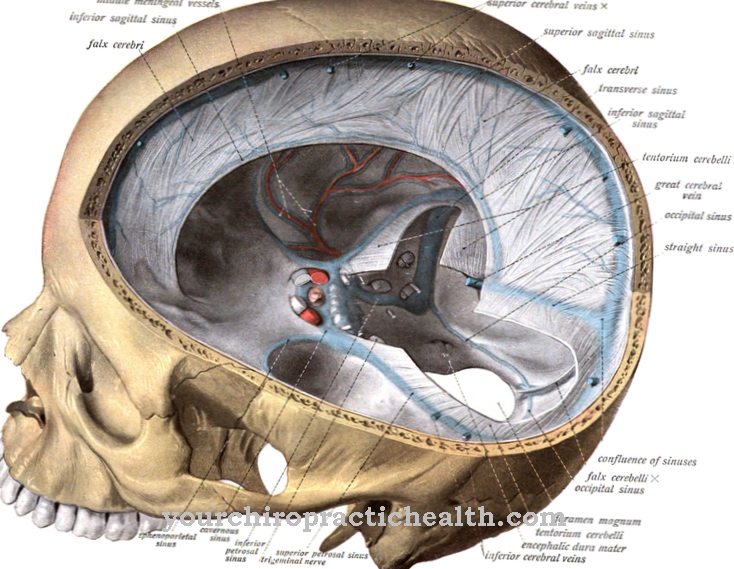The innervates on the back Thoracodorsal nerve the large back muscle and the large round muscle. Both play an important role in arm movements. Lesions occur, for example, in the context of neuralgic shoulder amyotrophy and arm plexus paralysis.
What is the thoracodorsal nerve?
The thoracodorsal nerve belongs to the peripheral nervous system and is one of the fibers of the brachial plexus. The nerve is mainly involved in controlling certain arm movements by innervating two muscles that lie on the back of humans.
These are the teres major and latissimus dorsi muscles. The name of the thoracodorsal nerve is derived from its characteristic course: its path first leads over the chest (thorax) before it ends on the back (dorsal) at the innervated muscles.
Arbitrary movement of the arm begins in the human brain. In the motor center, an electrical signal is generated that reaches the spinal cord via the nerve cells and leaves it through neural fibers that run through the spinal canal between two vertebrae. The origin of the thoracodorsal nerve lies in the spinal cord between the neck segments C6 and C8. Its path already divides at the spinal cord and extends symmetrically into both halves of the body.
Anatomy & structure
The thoracodorsal nerve belongs to the plexus of the arm, which physiology calls the brachial plexus. It represents a collection of different nerves that supply different shoulder, back and arm muscles with neurons.
They do not form a tightly enclosed, uniform tissue, but a loose collection of nerve fibers that belong to different pathways. The thoracodorsal nerve is a posterior fasciculus of the brachial plexus because it is one of the posterior branches. The posterior fibers in turn form a subunit of the infraclavicular branches of the nerve plexus: these branches are all located below the collarbone. In addition to the thoracodorsal nerve, they also include the subscapularis nerve, the radial nerve, the axillary nerve and six other nerves.
The thoracodorsal nerve sends its motor commands to the large back muscle (Musculus latissimus dorsi), which attaches to the front of the humerus; its origin is found on some thoracic and lumbar vertebrae as well as on the iliac bone, the thoracolumbar fascia, some ribs, the shoulder blade and sacrum (os sacrum). Other fibers of the thoracodorsal nerve lead to the teres major muscle, which is also located on the back, begins at the shoulder blade and attaches to the humerus. Before it reaches the muscles, the thoracodorsal nerve accompanies the subscapular artery in its course.
Function & tasks
The main task of the thoracodorsal nerve is to transmit nerve signals. The electric charge of the action potential spreads along the nerve fiber (axon) that originates from the associated nerve cell. Most of the nerve fibers in the human body are surrounded by Schwann cells, which form a natural insulating layer. The Schwann cells do not border one another without gaps.
These interruptions are Ranvier rings on which the cell along the axon is depolarized anew every time. If an action potential reaches such a section, it stimulates sodium ion channels located in the membrane. The sodium particles are positively charged: when they flow inside after the channels have opened, they therefore lead to a change in the electrical charge in this axon section. At the same time, the shift already stimulates the next segment.
To restore the cell to its original state, the interior of the axon first actively releases potassium ions. They are also positively charged and thus create a balance so that the electrical charge corresponds to the original. Only then do transport molecules in the membrane transport the correct particles back in and out until they also achieve the correct ionic composition.
In the meantime, the axon cannot form a new action potential in this segment, which is why the duration is also known as the refractory period. It lasts for about two milliseconds. For this reason, a single nerve fiber - in the thoracodorsal nerve and all other nerves - can only ever act as a one-way street for signals. However, different nerve fibers that are close together can cover both directions.
You can find your medication here
➔ Medicines for painDiseases
As a result of damage to the thoracodorsal nerve, motor and sensory disorders can manifest themselves. Such a lesion is possible, for example, in the context of neuralgic shoulder amyotrophy. It represents an inflammation of the brachial plexus, which also includes the thoracodorsal nerve.
The inflammation manifests itself as sudden severe pain in the shoulders and upper arm (one or both sides) before partial or complete paralysis (paresis) occurs about a week later and the muscle tissue finally disappears (atrophy). The main symptoms of the disease are the deltoid muscles, but the symptoms can also extend to the shoulder and arm muscles.
The diaphragm is less often affected. Investigations can usually detect antigen-antibody complexes (immune complexes) that indicate the presence of an infection. Although the exact causes of neuralgic shoulder amyotrophy have not yet been clarified, it appears to be related to viral infections, vaccine reactions, overload and heroin use.
Another example of damage to the thoracodorsal nerve is arm plexus paralysis, which is caused by injuries to the nerve roots. In this case, fibers of the brachial plexus tear off and as a result can no longer transmit signals. Birth trauma or external violence is usually responsible for the lesion. Depending on which fibers tear, the corresponding neurons fail.













.jpg)

.jpg)
.jpg)











.jpg)